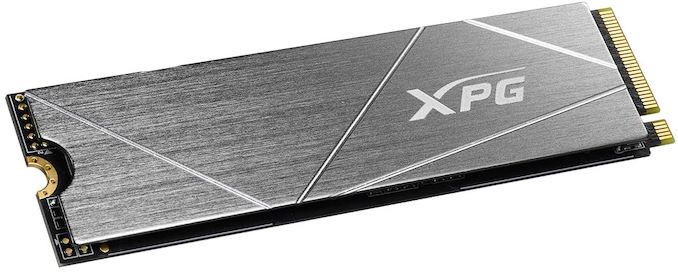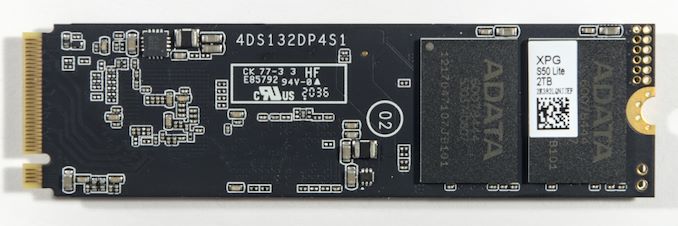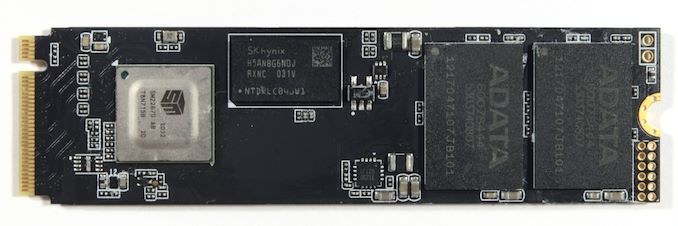The ADATA GAMMIX S50 Lite 2TB SSD Review: Mainstream PCIe Gen4
by Billy Tallis on April 30, 2021 8:00 AM EST
The roll-out of PCIe 4.0 support to consumer NVMe SSDs has been a long, drawn-out process so far, but it is progressing. Two waves of high-end SSDs have now hit the market, and last year we saw several brands introduce QLC-based SSDs using the now-outdated first-wave Gen4 SSD controller from Phison. More recently, PCIe 4.0 support has arrived for the mainstream mid-range market segment thanks to the ADATA XPG Gammix S50 Lite, based on the Silicon Motion SM2267 controller and TLC NAND flash memory.
The ADATA S50 Lite uses Silicon Motion's first PCie 4.0 SSD controller: the SM2267. Opting to start small, Silicon Motion has launched their mainstream SSD controller first, while their upcoming (overdue?) SM2264 will eventually be filling the high-end role.
To that end, the SM2267 serves Silicon Motion's lineup as a smaller, cheaper design aimed at mainstream consumer use cases. To accomplish this, Silicon Motion has built the SM2267 on a tried-and-true (and cheap) 28nm process and equipped the controller with 4 NAND channels, as opposed to the 12nm (or smaller) 8-channel controllers that are used in the latest high-end drives. This does limit maximum performance, but it also helps to keep costs in check, something that's especially useful during the current chip crunch.
Intel's recently-launched third generation QLC SSD (the Intel SSD 670p) uses a close relative of this controller; the SM2265 is an Intel-commissioned derivative of the SM2267 that lacks PCIe 4.0 support, but is otherwise identical in all the important ways. As we'll see from the S50 Lite's performance, the Intel 670p isn't missing out on much without that Gen4 support.
As for the subject of today's review, the ADATA XPG Gammix S50 Lite and its SM2267 controller is part of a growing trend of mainstream NVMe SSDs moving to 4-channel controllers rather than 8 channels. The capacity of individual NAND flash memory dies has grown to the point that an 8-channel controller is not necessary to get 2TB of flash connected, and the IO speed of recent generations of NAND flash is fast enough that a newer four-channel controller can match the performance of older 8-channel designs. This was first demonstrated to great effect by the SK hynix Gold P31. On paper, the Gammix S50 Lite promises more or less the same thing: performance that matches or slightly exceeds what we see from high-end PCIe Gen3 SSDs also using TLC NAND, despite working with half as many NAND channels.
| ADATA XPG Gammix S50 Lite Specifications | |||||
| Capacity | 512 GB | 1 TB | 2 TB | ||
| Form Factor | M.2 2280 double-sided with heatsink | ||||
| Interface | PCIe 4 x4, NVMe 1.4 | ||||
| Controller | Silicon Motion SM2267 | ||||
| NAND Flash | Intel/Micron 96L TLC | ||||
| DRAM | DDR4 | ||||
| Sequential Read (MB/s) | 3800 | 3900 | |||
| Sequential Write (MB/s) | 2800 | 3200 | |||
| Random Read IOPS (4kB) | 191k | 380k | 490k | ||
| Random Write IOPS (4kB) | 510k | 540k | |||
| Warranty | 5 years | ||||
| Write Endurance | 370 TB 0.4 DWPD |
740 TB 0.4 DWPD |
1480 TB 0.4 DWPD |
||
| Retail Price | $139.99 (14¢/GB) |
$235.99 (12¢/GB) |
|||
ADATA equips the S50 Lite with a fairly thick heatspreader, and like most of their Gammix SSDs, that heatspreader comes already attached to the drive rather than packaged separately as with their SX series drives. Instead of using their typical thermal paste, this heatspreader is attached with what is by far the most tenacious thermal tape we've ever encountered. It is reinforced with a tight-woven stiff fabric and the adhesive was strong enough that removing the heatspreader without permanently damaging the drive required copious use of solvents instead of just a bit of gentle prying.
So while we had originally speculated that the SM2267 controller might allow the S50 Lite to be the first Gen4 SSD suitable for laptop usage (hoping for similar power efficiency to the SK hynix Gold P31), this heatspreader plus the double-sided design means the S50 Lite will be a challenge to fit into some notebooks.
The SM2267 controller actually has a slightly higher pin count than the older 8-channel SM2262(EN) controllers, but the SM2267 uses denser packaging to fit in the same footprint as their earlier 4-channel SM2263 controller. The resulting PCB layout is not at all crowded, and could have easily been made into a single-sided design like the Intel 670p, had ADATA wanted to stack 16 NAND dies per package. Any future drives that use the DRAMless SM2267XT variant certainly should be single-sided.
Our 2TB S50 Lite sample is equipped with 1GB of DDR4 DRAM—half as much as we would typically expect from a mainstream or high-end SSD. As the high-end has moved on to PCIe Gen4, we have seen an increasing number of mid-range or low-end NVMe SSDs cut back from the usual 1GB per 1TB ratio of DRAM to NAND, and with the S50 Lite that trend has crossed over to Gen4. Having half or a fourth of the usual DRAM is nowhere near as serious a handicap as an entirely DRAMless SSD design, and will generally only make a difference for very storage-intense usage with heavy multitasking—workloads that are a bit beyond the intended use case for a drive like the S50 Lite.
Also noteworthy about the S50 Lite is that ADATA announced and published specs for a 512GB model, but we've only seen the 1TB and 2TB models hit the market.
The Competition
ADATA's original Gammix S50 was a Phison E16 drive: their first flagship Gen4 drive and part of the first wave of consumer Gen4 SSDs. That has since been superseded by the Gammix S70, and the S50 Lite slots into a lower position in their product stack. Standing in for the various Phison E16 TLC drives, we have test results from the Seagate FireCuda 520. We also have the Corsair MP600 CORE representing the Phison E16 QLC drive family.
Other PCIe Gen4 drives in this review include the WD Black SN850 and Samsung 980 PRO—both high-end models that are significantly more expensive.
The rest of the drives included in this review are a variety of more mainstream PCIe Gen3 SSDs and some relatively low-end NVMe options. Highlights include the Intel 670p (almost the same controller, but with QLC), the HP EX950 and Kingston KC2500 using the previous-generation SM2262EN controller, and Microcenter's Inland Premium representing the current crop of Phison E12S drives with TLC NAND and a reduced DRAM ratio.

















93 Comments
View All Comments
yannigr2 - Friday, April 30, 2021 - link
Years are passing by and the cost per GB is moving up instead of down.deil - Friday, April 30, 2021 - link
but speeds go up a lot. if you compare those to 60GB ssd's of 2005'ish those are 100x fasterStrangerGuy - Sunday, May 2, 2021 - link
Obviously he implies recent price trends in a market where some older products are clearly better then new ones not only in performance/$ but also in absolute performance.But sure please keep up your disingenuous trollish comparisons. Maybe you would also want to elaborate how current GPUs aren't overpriced because they are a million times faster than the 1998 TNT?
TheinsanegamerN - Thursday, May 6, 2021 - link
Take a chill pill dude. You still get way more bang for your buck on sSDs now then you did 3-4 years ago. 4-8TB m.2 drives wern't even an option back then, and PCIe gen 4 is expensive to implement compared to gen 3.Also current GPUs are no more overpriced then the 8800ultra was, which adjusted for inflation was $1100, with NO mining excuses. Didnt even have 1GB of RAM FFS.
Linustechtips12#6900xt - Friday, April 30, 2021 - link
well I think part of that is due to the chip shortage currently but i do agree, things like the intel 660p ssd are a great example of nand prices going down and for the btter a 1tb 90$ ssd, AMAZING as far as im concerned and most notebooks use ssds rather than hard drives, prices havent really gone up much for that super amazing benefit.Oxford Guy - Friday, April 30, 2021 - link
Part of that is the fact that QLC actively works against consumer value, by reducing the economy of scale cost-reduction benefit for TLC.People are literally giving themselves an arrow to the knee when they buy QLC.
Billy Tallis - Friday, April 30, 2021 - link
You keep posting this comment on every article about storage, but that doesn't make it true. Your notion of "economy of scale" is pathetically naive and unconnected to the reality of how NAND flash memory is manufactured. Economies of scale in semiconductor manufacturing come primarily from having more and larger fabs. Using two different mask sets with those production lines instead of just one doesn't ruin those economies of scale. If it did, then you should have been complaining about companies manufacturing both 256Gbit and 512Gbit TLC dies at the same time.Oxford Guy - Friday, April 30, 2021 - link
Calling my argument 'pathetically naive' doesn't make your opinions true either.'Economies of scale in semiconductor manufacturing come primarily from having more and larger fabs. Using two different mask sets with those production lines instead of just one doesn't ruin those economies of scale.'
The reality is that every dollar consumers spend on QLC is a dollar less spent on TLC. That reduces the economy of scale for TLC by reducing TLC production.
Billy Tallis - Saturday, May 1, 2021 - link
"The reality is that every dollar consumers spend on QLC is a dollar less spent on TLC. That reduces the economy of scale for TLC by reducing TLC production."You have no basis for believing that adding some QLC to the mix of a NAND fab's output meaningfully affects the marginal cost of TLC production. I've never seen you hypothesize any mechanism for how that would actually work. You just keep asserting a general economic principal as if it's a fundamental law.
Oxford Guy - Tuesday, May 4, 2021 - link
You are trying to make this seem complex when it's extremely simple.As we have already seen with SLC and MLC, when a cheaper-to-produce technology comes along, production shifts to producing that technology -- reducing availability of the previous products. (That was a serious drawback for consumers before 3D manufacturing made TLC a much better solution than it was.) Scarcity + demand = higher prices. Reducing production increases scarcity. Eventually, it also generally reduces demand which, in turn, reduces production further.
We have already seen this with MLC. It's rather incredible to see anyone claim there is no evidence of exactly the process I've described. It's also extremely simple, and factual, that every dollar spent on QLC is a dollar not spent on TLC -- nor MLC.